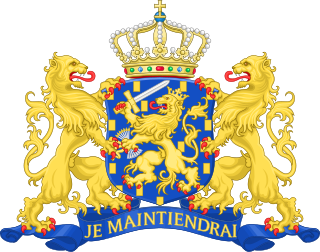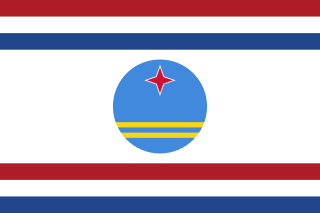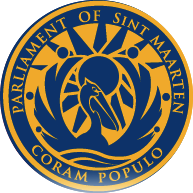
The Netherlands Antilles was a constituent country of the Kingdom of the Netherlands. The country consisted of several island territories located in the Caribbean Sea. The islands were also informally known as the Dutch Antilles. The country came into being in 1954 as the autonomous successor of the Dutch colony of Curaçao and Dependencies. The Antilles were dissolved in 2010. The Dutch colony of Surinam, although it was relatively close by on the continent of South America, did not become part of the Netherlands Antilles but became a separate autonomous country in 1954. All the island territories that belonged to the Netherlands Antilles remain part of the kingdom today, although the legal status of each differs. As a group they are still commonly called the Dutch Caribbean, regardless of their legal status. People from this former territory continue to be called Antilleans in the Netherlands.
The politics of the Netherlands Antilles, a former constituent country of the Kingdom of the Netherlands, existed in a framework of a parliamentary representative democratic country, in which the prime minister was the head of government, and of a multi-party system. Executive power was exercised by the government. Federal legislative power was vested in both the government and parliament. The Judiciary was independent of the executive and the legislature. The Netherlands Antilles had full autonomy on most matters. Exceptions were defence, foreign affairs, and the Supreme Court.

The prime minister of the Netherlands is the head of the executive branch of the Government of the Netherlands. Although the monarch is the de jure head of government, the prime minister de facto occupies this role as the officeholder chairs the Council of Ministers and coordinates its policy with the rest of the cabinet. The current prime minister has been Mark Rutte since 14 October 2010, whose fourth cabinet was inaugurated on 10 January 2022.

The 'National Alliance' is a political alliance in Sint Maarten, formed by the Sint Maarten Patriotic Alliance and the National Progressive Party. It is one of main political parties within Sint Maarten. At the legislative elections in the Netherlands Antilles, 18 January 2002, the alliance won 4.8% of the popular vote of Sint Maarten and 1 out of 22 seats. At the elections in the Netherlands Antilles of 27 January 2006, it won one extra seat.

Sint Maarten is a constituent country of the Kingdom of the Netherlands in the Caribbean. With a population of 41,486 as of January 2019 on an area of 41.44 km2 (16.00 sq mi), it encompasses the southern 44% of the divided island of Saint Martin, while the northern 56% of the island constitutes the French overseas collectivity of Saint Martin. Sint Maarten's capital is Philipsburg. Collectively, Sint Maarten and the other Dutch islands in the Caribbean are often called the Dutch Caribbean.

The Charter for the Kingdom of the Netherlands is a legal instrument that sets out the political relationship between the four countries that constitute the Kingdom of the Netherlands: Aruba, Curaçao, and Sint Maarten in the Caribbean and the Netherlands in Europe. It is the leading legal document of the Kingdom. The Constitution of the Netherlands and the Basic Laws of the three other countries are legally subordinate to the Charter.
The governor of the Netherlands Antilles was the representative of the Kingdom of the Netherlands in the Netherlands Antilles and the head of the government of the Netherlands Antilles.

The Netherlands Antilles was an autonomous Caribbean country within the Kingdom of the Netherlands. It was dissolved on 10 October 2010.

The flag of Sint Maarten consists of a white triangle situated at the hoist charged with the constituent country's coat of arms, along with two horizontal bands of red and blue. Adopted in 1985 shortly after the territory was granted a coat of arms, it has been the flag of Sint Maarten since 13 June of that year. Since the dissolution of the Netherlands Antilles on 10 October 2010, it has been the sole flag used in the constituent country.

The governor of Aruba is the representative on Aruba of the Dutch monarch. The governor's duties are twofold; he represents and guards the general interests of the Kingdom of the Netherlands and is head of the Aruban government. He is accountable to the government of the kingdom. As the head of the Aruban government, the governor is inviolable; the ministers are responsible. The governor does not have political responsibilities and is not part of the Aruban cabinet. During the formation of a cabinet, the governor plays an important role. The governor is appointed by the monarch for a period of six years. This period can be prolonged for one more term of six years. The governor is supported and advised by the Council of Advice, consisting of at least five members, appointed by the governor, advising him on the drafts of state ordinances, state decrees, kingdom acts and general administrative orders.

The following outline is provided as an overview of and topical guide to the Netherlands Antilles:

The Kingdom of the Netherlands, commonly known as simply the Netherlands, is a sovereign state and constitutional monarchy with 98% of its territory and population in Western Europe and with several small West Indian island territories in the Caribbean.

The Caribbean Netherlands are the three public bodies of the Netherlands that are located in the Caribbean Sea. They consist of the islands of Bonaire, Sint Eustatius and Saba, although the term "Caribbean Netherlands" is sometimes used to refer to all of the islands in the Dutch Caribbean. In legislation, the three islands are also known as Bonaire, Sint Eustatius and Saba or the BES islands. The islands are currently classified as public bodies in the Netherlands and as overseas countries and territories of the European Union; thus, EU law does not automatically apply.

The governor of Curaçao is the representative on Curaçao of the Dutch head of state. The governor's duties are twofold: representing and guarding the general interests of the Kingdom and heading the government of Curaçao. The governor is accountable to the government of the Kingdom of the Netherlands. As the head of the government, the governor is immune. The governor exercises the executive power under the responsibility of the ministers, who are responsible to the Estates of Curaçao. The governor does not have political responsibilities and is not part of the cabinet. During the formation of a cabinet the governor plays an important role. The governor is appointed by the monarch for a period of six years. This period can be prolonged for one more term of six years. The governor is supported by his secretariat the cabinet of the governor, and is advised by the Council of Advice, consisting of at least five members, appointed by the governor, who advise on the drafts of state ordinances, state decrees, kingdom acts and general administrative orders.

The Parliament of Sint Maarten is a unicameral legislature that consists of 15 members, each elected for a four-year term in a general election. The first parliament was installed on 10 October 2010, the date of the dissolution of the Netherlands Antilles, and consisted of the members of the island council elected on 17 September 2010. The current President of Parliament is Grisha Heyliger-Marten.

The government of Curaçao, a "constituent country" of the Kingdom of the Netherlands, takes place in a framework of a parliamentary representative democratic country, whereby the prime minister is the head of government, and of a multi-party system. Executive power is exercised by the government. Legislative power is vested in both the government and parliament. The judiciary is independent of the executive and the legislature. Curaçao has full autonomy on most matters, with the exceptions summed up in the Charter for the Kingdom of the Netherlands under the title "Kingdom affairs". The Constitution of Curaçao was ratified in September 2010, and entered into force on 10 October 2010 upon the dissolution of the Netherlands Antilles.

Sint Maarten, a constituent country of the Kingdom of the Netherlands, has a government formed by the monarch, represented by the governor, and the ministers. The prime minister presides the council of ministers. Executive power is exercised by the government. Legislative power is vested in both the government and parliament. The minister plenipotentiary is not part of the government and represents the Sint Maarten government in the Netherlands. The judiciary is independent of the executive and the legislature. The country is a parliamentary representative democratic country with a multi-party system. Sint Maarten has full autonomy on most matters, with the exceptions summed up in the Charter for the Kingdom of the Netherlands under the title "Kingdom affairs". The Constitution of Sint Maarten was ratified in September 2010, and entered into force on 10 October 2010.

The Dutch Caribbean are the territories, colonies, and countries, former and current, of the Dutch Empire and the Kingdom of the Netherlands in the Caribbean Sea. They are in the north and south-west of the Lesser Antilles archipelago.

General elections were held in Curaçao on 19 October 2012. Early elections for the Curaçao island council were necessary as the Cabinet-Schotte lost its majority in the Estates of Curaçao. The elections were the first of the Curaçao after obtaining the status of country within the Kingdom of the Netherlands upon the dissolution of the Netherlands Antilles in 2010. The election saw six parties obtain one or more of the 21 seats, with Sovereign People and Movement for the Future of Curaçao both winning five.

Jaime Mercelino Saleh is a Dutch Antillean politician and former judge. He was a judge on the Joint Court of Justice of the Netherlands Antilles from 1974 to 1990 and was its president from 1979. Saleh subsequently served as Governor of the Netherlands Antilles between 1990 and 2002.














